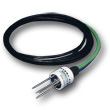Soil moisture Impedance-method (Hydra Probe II)
Parameter to be measured:
Soil moisture
Method:
Frequency Domain Sensor working with the so called impedance-method
Equipment:
- Stevens: Hydra Probe II
Advantages:
- easy and fast measurement of punctual soil moisture
- manual as well as continuously logged measurements possible
Disadvantages:
- Each sensor has to be calibrated
- careful application of probe in stony soils
- Underestimating of permittivity in media with low permitivity (ε > 40, clay and organic soils)
What to watch out for:
- Good contact between probe and medium has to be prooved
Problems/Questions:
Links
Other related web sites:
- sowacs.com - the central resource for soil moisture measurement
- Stevens: Manual & Theory
References
- Blonquist, JM; Jones, SB; Robinson, DA. 2005. Standardizing characterization of electromagnetic water content sensors: Part 2. Evaluation of seven sensing systems. VADOSE ZONE JOURNAL 4(4), 1059-1069.
- Kelleners, TJ; Ferre-Pikal, ES; Schaap MG; Paige, GB. 2009. Calibration of Hydra Impedance Probes using Electric Circuit Theory. SOIL SCIENCE SOCIETY OF AMERICA JOURNAL 73(2), 453-465, DOI: 10.2136/sssaj2008.0151.
- Logsdon, SD; Green, TR; Seyfried, M; Evett, SR; Bonta, J. 2010. Hydra Probe and Twelve Wire Probe Comparisons in Fluids and Soil Cores. SOIL SCIENCE SOCIETY OF AMERICA JOURNAL 74, 5-12, DOI: 10.2136/sssaj2009.0189.
- Seyfried, MS; Murdock, MD. 2004. Measurement of soil water content with a 50-MHz soil dielectric sensor. SOIL SCIENCE SOCIETY OF AMERICA JOURNAL 68(2), 394-403.
- Seyfried, MS; Grant, LE. 2007. Temperature Effects on Soil Dielectric Properties Measured at 50 MHz. VADOSE ZONE JOURNAL 6(4), 759-765.
